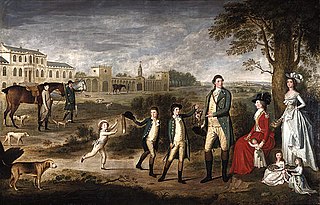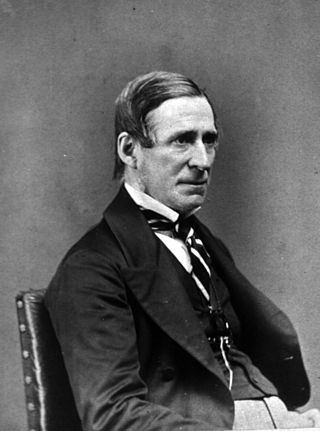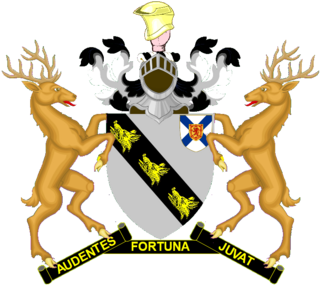Notes
This article needs additional citations for verification .(June 2016) |
- ↑ "No. 41035". The London Gazette . 29 March 1957. p. 1959.
The Henderson-Stewart Baronetcy, of Callumshill in the County of Perth, is a title in the Baronetage of the United Kingdom. [1] It was created on 28 March 1957 for James Henderson-Stewart, Member of Parliament for East Fife from 1933 to 1961 and Joint Under-Secretary of State for Scotland from 1952 to 1957. As of 2010, the title is held by his son, the second Baronet, who succeeded in 1961.
The heir apparent is the present holder's son David Henderson-Stewart (born 1973).
This article needs additional citations for verification .(June 2016) |

Earl of Galloway is a title in the Peerage of Scotland. It was created in 1623 for Alexander Stewart, 1st Lord Garlies, with remainder to his heirs male bearing the name and arms of Stewart. He had already been created Lord Garlies in the Peerage of Scotland in 1607, with remainder to the heirs male of his body succeeding to the estates of Garlies. This branch of the Stewart family were distant relatives of the Stewart Kings of Scotland.

Viscount St Davids, of Lydstep Haven in the County of Pembroke, is a title in the Peerage of the United Kingdom. It was created in 1918 for John Philipps, 1st Baron St Davids. The Philipps family descends from Sir John Philipps, who represented Pembrokeshire in the House of Commons. In 1621 he was created a Baronet, of Picton Castle in the County of Pembroke, in the Baronetage of England. His grandson, the third Baronet, also sat as Member of Parliament for Pembrokeshire. He was succeeded by his son, the fourth Baronet. He represented Pembroke and Haverfordwest in Parliament. His son, the fifth Baronet, sat for Haverfordwest. He was succeeded by his younger brother, the sixth Baronet. He represented Carmarthen, Petersfield and Pembrokeshire in the House of Commons.

Baron Faringdon, of Buscot Park in the County of Berkshire, is a title in the Peerage of the United Kingdom. It was created in 1916 for Sir Alexander Henderson, 1st Baronet, who had previously represented Stafford West and St George's, Hanover Square in the House of Commons as a Liberal Unionist. He had already been created a baronet in 1902. He was succeeded by his grandson, the second Baron. He was the son of the Hon. Harold Henderson, eldest son of the first Baron, who predeceased his father. Lord Faringdon was a member of the London County Council. As of 2017 the titles are held by his nephew, the third Baron, who succeeded in 1977. He is the son of the Hon. Michael Thomas Handerson, second son of the Hon. Harold Henderson.

Baron Glentoran, of Ballyalloly in the County of Down, is a title in the Peerage of the United Kingdom. It was created on 8 July 1939 for the Unionist politician Herbert Dixon. In 1950 he also succeeded his elder brother as third Baronet, of Ballymenock. His son, the second Baron, was also a politician and served as the last Speaker of the Senate of Northern Ireland. As of 2017 the titles are held by the latter's son, the third Baron, who succeeded in 1995. He is a former Olympic bobsleigh gold medallist as well as a soldier, businessman and politician. Lord Glentoran was one of the ninety elected hereditary peers who remain in the House of Lords after the passing of the House of Lords Act 1999, and sat on the Conservative benches until his June 2018 retirement under the House of Lords Reform Act 2014.

Baron Milford is a title that has been created three times, once in the Peerage of Ireland and twice in the Peerage of the United Kingdom. All three creations have been for members of the same family. The first creation came in the Peerage of Ireland in 1776 when Sir Richard Philipps, 7th Baronet, of Picton Castle was made Baron Milford. However, this title became extinct on his death in 1823, while the baronetcy was passed on to a distant relative. The title was revived in the Peerage of the United Kingdom in 1847 when Sir Richard Philipps, 1st Baronet, of Picton Castle was created Baron Milford, of Picton Castle in the County of Pembroke. Born Richard Bulkeley Philipps Grant, he was the son of John Grant and Mary Philippa Artemisia, daughter of James Child and Mary Philippa Artemisia, daughter of Bulkeley Philipps, uncle of the first Baron of the first creation. He succeeded to the Philipps estates in 1823 and assumed the surname of Philipps the same year. In 1828 he was created a Baronet, of Picton Castle in the County of Pembroke, in the Baronetage of the United Kingdom. However, Lord Milford was childless and the titles became extinct on his death in 1857. He devised his estates to his half-brother Reverend James Henry Alexander Gwyther, who assumed the surname of Philipps. James's daughter Mary Philippa married Charles Edward Gregg Fisher, who assumed the surname of Philipps and was created a Baronet, of Picton, in 1887.

The HaringtonBaronetcy, of Ridlington in the county of Rutland, is a title in the Baronetage of England. It was created on 29 June 1611 for James Harington. He was a descendant of John Harington, one of the Barons summoned to Parliament by Edward II. James's elder brother was John Harington, 1st Baron Harington of Exton. The second Baronet was a Royalist during the English Civil War. The third Baronet was a Major-General in the Parliamentarian Army and one of the judges appointed to try Charles I, although he refused to sit. He was nonetheless excepted from the Indemnity and Oblivion Act and his title was forfeited for life in 1661. The ninth, eleventh, and twelfth Baronets were all judges. The family is one of two families to have produced three County Court judges.

There have been five baronetcies of the United Kingdom created for a person with the surname Erskine, two in the Baronetage of Nova Scotia, one in the Baronetage of Great Britain and two in the Baronetage of the United Kingdom. Two of the creations are extant as of 2010.
There have been five Baronetcies created for people with the surname Forbes, four in the Baronetage of Nova Scotia and one in the Baronetage of the United Kingdom. The first holder of the Burn Baronetcy of Jessfield, created in the Baronetage of the United Kingdom in 1923, assumed the surname of Forbes-Leith of Fyvie in 1925.
There have been two baronetcies created for persons with the surname Ross, both in the Baronetage of the United Kingdom. One creation is extinct while one is still extant.

There have been four baronetcies created for persons with the surname Hope, three in the Baronetage of Nova Scotia and one in the Baronetage of the United Kingdom. As of 2010 one creation is extant, one dormant and two extinct.
The Stewart-Clark Baronetcy, of Dundas in the County of West Lothian, is a title in the Baronetage of the United Kingdom. It was created on 12 February 1918 for John Stewart-Clark. He was a director of the firm of Clark & Co. Born John Clark, he assumed the additional surname of Stewart in 1909.
The Richardson, later Stewart-Richardson Baronetcy, of Pencaitland in the County of Haddington, is a title in the Baronetage of Nova Scotia. It was created on 13 November 1630 for Robert Richardson, with remainder to his heirs male whatsoever. The title was dormant from c. 1640–c. 1678, 1752–c. 1783 and 1821–1837. The thirteenth Baronet was the son of Elizabeth, eldest daughter and co-heir of James Stewart, and assumed the additional surname of Stewart.
The Spicer Baronetcy, of Lancaster Gate in the Borough of Paddington, is a title in the Baronetage of the United Kingdom. It was created on 17 July 1906 for Albert Spicer. He was Chairman of James Spicer & Sons Ltd, paper makers, and also represented Monmouth and Hackney Central in the House of Commons as a Liberal. The fourth Baronet did not use his title.

There have been three baronetcies created for persons with the surname Paget, all in the Baronetage of the United Kingdom, and a fourth created for the Bayly, which later became the Paget Baronetcy. As of 2016, two of the creations are extant.
There have been six baronetcies created for persons with the surname Thomas, three in the Baronetage of England, one in the Baronetage of Great Britain and two in the Baronetage of the United Kingdom. Two of the creations are extant as of 2016.
There have been two baronetcies created for persons with the surname Rankin, both in the Baronetage of the United Kingdom. One creation is extant as of 2007.
The Fairbairn Baronetcy, of Ardwick in the parish of Manchester in the County Palatine of Lancaster, is a title in the Baronetage of the United Kingdom. It was created on 2 November 1869 for the prominent Scottish engineer William Fairbairn. Another member of the family to gain distinction was Bernard Fairbairn (1880–1965), grandson of William Andrew Fairbairn, fourth son of the first Baronet. He was a vice-admiral in the Royal Navy.

The Turing Baronetcy, of Foveran in the County of Aberdeen, is a title in the Baronetage of Nova Scotia. It was created in 1638 for John Turing, who was granted the barony of Foveran in Aberdeenshire by the king. He was a supporter of Charles I and was taken prisoner by the Covenanters in 1639. In 1651, he fought at the Battle of Worcester. The Turing family descends from Sir William Turing, a supporter of David II (1329–1371).
There have been five baronetcies created for persons with the surname Home, four in the Baronetage of Nova Scotia and one in the Baronetage of the United Kingdom. Only one creation is extant as of 2008.
The Nicolson baronets refer to one of four baronetcies created for persons with the surname Nicolson, all in the Baronetage of Nova Scotia. Two of the creations remain extant as of 2008.